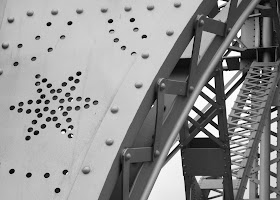Just 19 transporter - in the States known as aerial transfer or aerial ferry - bridges were built to completion worldwide, all between 1893 and 1916, except for one of 1938. Such structures were very much a European phenomenon; only one was ever constructed in North America, at Duluth, MI. (The Sky Ride built for the 1933 Century of Progress World's Fair in Chicago is often cited as a transporter bridge, but was in fact an aerial tramway.)
Duluth, at the western end of Lake Superior, is the largest inland port in the world. In 1870-71 the Duluth Ship Canal was cut through Minnesota (alternatively Park) Point, a seven mile long sand spit, in order to provide sheltered docks. Much of the spit was rendered an island. Ferries crossing the canal were unable to operate due to ice in winter, during which an inadequate suspension footbridge would be erected.
A 1891 competition sought a solution. The city decided to pursue one of the submitted proposals, for a vertical lift bridge designed by John Alexander Low Waddell, but the scheme foundered the following year due to objections from the War Department. Waddell's lift bridge was ultimately built, in 1894, but in Chicago, as the Halstead Street Bridge. A second competition sought a tunnel solution, but this idea sank too.
Meanwhile, between 1896 and 1902, the canal was widened and deepened. Thomas F. McGilvray, City Engineer at the time, inspired by the transporter bridges of Europe, in 1899 sketched one such, although of trussed rather than suspension form, as a way forward. The engineer C.A.P. Turner turned the sketch into a design, approved in 1901. The bridge had a main span of 393' 9", provided for a clearance of 135' above mean high water, and carried a gondola suspended by rigid steel hangers, instead of cables.
The foundations, built by Hugo & Timms, of Duluth, were completed by March 1902. However, funding difficulties with the American Bridge Company, and then steel supply problems affecting their subsidiary, the Duluth Canal Bridge Company, meant the bridge itself didn't proceed. DCBC's contract lapsed in May 1903.
Construction, by the Modern Steel Structural Company, of Waukesha, WI, finally commenced in July 1904. The first crossing of the gondola, 50 feet long, and 30 feet wide, took place on 23 February 1905. The crossing took about 1¼ minutes. Load-tested with 65 tons on 24 March, the bridge opened to the public three days later. The first car, an electric Studebaker Stanhope, crossed on 8 April.
However, as was the case with all transporter bridges, increased car ownership and usage rendered the bridge inadequate to demand by the mid-1920s. A redesign was undertaken in 1927 by John L. Harrington, of Harrington, Howard & Ash, of Kansas City. The solution was a lift bridge, remarkably similar to that designed by Waddell, with whom Harrington had once been a partner. The design was approved by the city in February 1927 and in January the following year received the blessing of Congress.
The contract was awarded to the Kansas City Bridge Company in February 1929, and work started the next month. The gondola crossed the canal for the last time on 1 July 1929. The re-engineering involved raising the towers 41 feet to accommodate the deck without compromising the 135' clearance, and strengthening them to carry the additional weight by building additional towers within the old ones. To avoid interruption to shipping, the 900 ton moving deck, counterbalanced by a 450 ton concrete weight in each tower, was constructed in the lifted position.
The converted bridge was first used on 12 January 1930. As ships and boats approach they blow a long-short-long-short signal on their horn, although lifts, which take just a minute, are largely radioed for about 1½ miles out. The signal is copied back by the bridge on its pair of Westinghouse Air Brake locomotive horn sets. There are about five thousand lifts per year. The bridge was added to the National Register of Historic Places in May 1973.









Hi nice reading your poost
ReplyDeleteThis is fascinating information about transporter bridges.
ReplyDelete